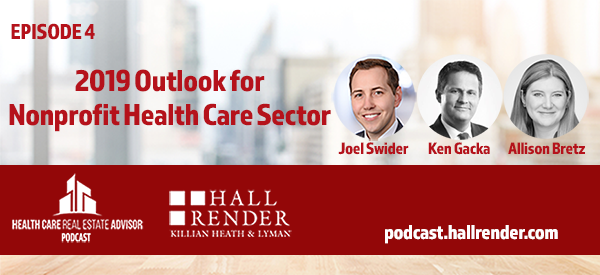S&P Global Ratings, Fitch Ratings and Moody’s Investors Service recently released their Nonprofit Healthcare 2019 Outlooks, which are largely consistent with 2018, despite changes in the health care industry over the past year. Fitch and Moody’s issued negative outlooks for the nonprofit health care sector, while S&P’s sector outlook was stable. Despite their differing views on the future of the industry, they each agreed that nonprofit hospitals will continue to face a variety of short-term and long-term regulatory and business challenges.
1. Credit Strength for Nonprofit Hospitals Is Strong but Declining
Both Fitch and S&P released stable credit outlooks (which are separate from their broader sector outlooks) based on the nonprofit hospitals they reviewed. Over 75 percent of nonprofit hospitals in Fitch’s portfolio had an ‘A-‘ or above; in S&P’s portfolio, over 90 percent of nonprofit health systems and over 50 percent of stand-alone nonprofit hospitals had an ‘A-‘ rating or better, and 23 percent of stand-alone hospitals had either a ‘BBB+’ or ‘BBB’ rating. Both ratings agencies observed a relative balance between upgrades and downgrades over the prior year.
Despite stable credit expectations, the 2019 Outlooks signaled caution, noting that although expense growth rates may be slowing, they still exceed revenue growth rates in the sector. For example, Moody’s predicts operating cash flows for nonprofit hospitals will remain flat or decline slightly in 2019, as revenue growth for these hospitals continues to decline and overall expenses increase. Moody’s projects the growth rate for nonprofit hospitals to be between 4 and 5 percent, which is consistent with the 4.8 percent growth rate in 2018 but substantially less than the 5.7 percent rate in 2017. Some of this decline can be attributed to hospitals’ attempts to cut costs. Yet despite these attempts, expenses continue to outpace revenue increases.
Several factors are stifling revenue growth rates for nonprofit hospitals, including:
- Accelerating bad debt levels, resulting from narrower third-party insurance coverage and rising copays and deductibles;
- Increasing numbers of patients covered by Medicare—which is unlikely to be reformed in the coming year given the stalemate in Congress—further restricting hospitals’ operational flexibility; and
- Weak or declining inpatient admissions in 2019, as outpatient competitors continue to shift utilization from inpatient to less costly (and typically lower-margin) outpatient services.
2. Expect Continued Consolidation and Increased Regulatory Scrutiny
All three agencies forecasted continued consolidation for nonprofit hospital systems in the coming year. These agencies identified considerable cost reductions, managerial and technical synergies and improved leverage with payers as significant incentives for smaller, underperforming providers to entertain acquisition offers by larger health systems. Larger hospitals and health systems may also look to partner with or acquire nontraditional entrants to diversify their services and expand their footprints. S&P anticipates that with increased consolidation may come increased state and federal regulatory scrutiny, as regulators increasingly voice concerns that these transactions reduce competition and contribute to rising health care costs.
3. Nonprofit Hospitals Should Expect Increased Competition from Non-Traditional Competitors
The ratings agencies noted that nonprofit hospitals will face a number of external threats in 2019, which are likely to continue in the coming decade. All three agencies pointed to nontraditional health care providers as a major threat to nonprofit hospitals. For example, new providers such as Amazon and Walmart are attempting to lure commercially insured or Medicare Advantage patients by creating and offering low-cost alternatives. Private equity entities are also investing in health care, exemplified by KKR & Co.’s acquisition of physician staffing and ambulatory surgery company Envision Healthcare Corporation. Hospitals also have to contend with vertical consolidation among health insurers, providers and pharmacy benefit managers. Mergers, such as those between CVS Health and Aetna Inc., as well as Cigna Corp. and Express Scripts, will likely further redirect business and care away from nonprofit hospitals.
Moreover, both governmental and commercial insurers are developing strategies to shift hospitals from volume-based to value-based care models with the goal of better value, lower costs and an improved experience for patients. These value-based reimbursement models are designed to encourage hospitals and physicians to provide high-quality, cost-effective care rather than focus on admission and surgery levels. These models involve a payment arrangement in which hospitals, to varying extents, will share either losses or gains with the insurer based on whether expenses are higher or lower than expected. Many hospitals have dabbled with these models to varying degrees, but the ratings agencies expect a continued overall shift as hospitals prepare for more value-based models in the future.
4. The Likelihood of a Recession Within the Health Care Sector Continues to Grow
The potential of recession looms over the entire market and especially the health care sector. S&P marked the chance of recession over the next 12 months to be between 15 and 20 percent, up from 10 to 15 percent at this time last year. It has been 11 years since the end of the 2008 recession, marking one of the longest economic expansions in U.S. history. Although predicting a recession is difficult, many financial experts believe the country is due for one soon. S&P and Moody’s gave specific attention to the threat of recession, and Fitch also cited the specter of a macroeconomic slowdown in its outlook.
If you have any questions or would like more information, please contact
- Joel Swider at (317) 429-3638 or jswider@wp.hallrender.com;
- Addison Bradford at (317) 977-1403 or abradford@wp.hallrender.com;
- Jerimi Ullom at (317) 977-1488 or jullom@wp.hallrender.com; or
- Your regular Hall Render attorney.




